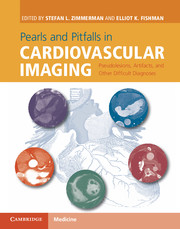 Pearls and Pitfalls in Cardiovascular Imaging
Pearls and Pitfalls in Cardiovascular Imaging from Section 7 - Acute aorta and aortic aneurysms
Published online by Cambridge University Press: 05 June 2015
Imaging description
The aortic wall comprises three layers: intima, media, and adventitia. The wall is imperceptible and inferred on contrast-enhanced CT by a boundary separating two tissues of contrasting attenuations: arterial lumen and the periarterial soft tissue. Processes such as intramural hematoma (IMH) that thicken the media expand the wall and displace the intimal layer inwards toward the lumen.
Aortic calcifications are usually centered on the intima and are, therefore, peripherally located (Figure 59.1). A process in the media that displaces the intima renders the calcifications non-peripheral (Figures 59.2A and 59.3).
However, non-peripheral calcifications can also be dystrophic calcifications of the mural thrombus, also known as neointimal calcifications (Figures 59.2B, 59.4, and 59.5).
How can the distinction be made on unenhanced CT?
Neointimal calcifications are chunky and random, since any part of the thrombus can calcify (Figure 59.2B). Intimal calcifications are thin, linear, and circumferentially configured (Figure 59.2A).
Neointimal calcifications may co-exist with intimal calcifications, in which case there are calcifications peripheral to neointimal calcifications (Figure 59.4).
Mural thrombus is of a lower attenuation (< 30 HU) than acute intramural hematoma (50–80 HU) and blood pool (40–50 HU).
Importance
Distinguishing between neointimal calcifications and displaced intimal calcifications is important because the latter reflects acute aortic pathology such as IMH and dissection. Dystrophic calcifications of the mural thrombus reflect an indolent process. The pitfall can result in incorrect diagnosis of acute aortic syndrome.
To save this book to your Kindle, first ensure no-reply@cambridge.org is added to your Approved Personal Document E-mail List under your Personal Document Settings on the Manage Your Content and Devices page of your Amazon account. Then enter the ‘name’ part of your Kindle email address below. Find out more about saving to your Kindle.
Note you can select to save to either the @free.kindle.com or @kindle.com variations. ‘@free.kindle.com’ emails are free but can only be saved to your device when it is connected to wi-fi. ‘@kindle.com’ emails can be delivered even when you are not connected to wi-fi, but note that service fees apply.
Find out more about the Kindle Personal Document Service.
To save content items to your account, please confirm that you agree to abide by our usage policies. If this is the first time you use this feature, you will be asked to authorise Cambridge Core to connect with your account. Find out more about saving content to Dropbox.
To save content items to your account, please confirm that you agree to abide by our usage policies. If this is the first time you use this feature, you will be asked to authorise Cambridge Core to connect with your account. Find out more about saving content to Google Drive.